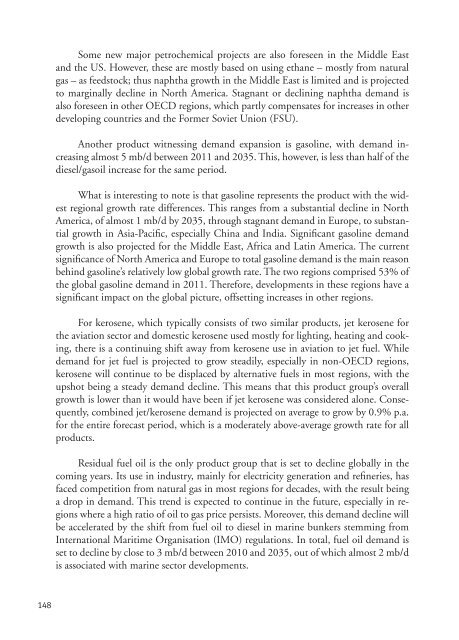World Oil Outlook - Opec
World Oil Outlook - Opec
World Oil Outlook - Opec
- TAGS
- world
- outlook
- opec
- www.opec.org
Create successful ePaper yourself
Turn your PDF publications into a flip-book with our unique Google optimized e-Paper software.
148<br />
Some new major petrochemical projects are also foreseen in the Middle East<br />
and the US. However, these are mostly based on using ethane – mostly from natural<br />
gas – as feedstock; thus naphtha growth in the Middle East is limited and is projected<br />
to marginally decline in North America. Stagnant or declining naphtha demand is<br />
also foreseen in other OECD regions, which partly compensates for increases in other<br />
developing countries and the Former Soviet Union (FSU).<br />
Another product witnessing demand expansion is gasoline, with demand increasing<br />
almost 5 mb/d between 2011 and 2035. This, however, is less than half of the<br />
diesel/gasoil increase for the same period.<br />
What is interesting to note is that gasoline represents the product with the widest<br />
regional growth rate differences. This ranges from a substantial decline in North<br />
America, of almost 1 mb/d by 2035, through stagnant demand in Europe, to substantial<br />
growth in Asia-Pacific, especially China and India. Significant gasoline demand<br />
growth is also projected for the Middle East, Africa and Latin America. The current<br />
significance of North America and Europe to total gasoline demand is the main reason<br />
behind gasoline’s relatively low global growth rate. The two regions comprised 53% of<br />
the global gasoline demand in 2011. Therefore, developments in these regions have a<br />
significant impact on the global picture, offsetting increases in other regions.<br />
For kerosene, which typically consists of two similar products, jet kerosene for<br />
the aviation sector and domestic kerosene used mostly for lighting, heating and cooking,<br />
there is a continuing shift away from kerosene use in aviation to jet fuel. While<br />
demand for jet fuel is projected to grow steadily, especially in non-OECD regions,<br />
kerosene will continue to be displaced by alternative fuels in most regions, with the<br />
upshot being a steady demand decline. This means that this product group’s overall<br />
growth is lower than it would have been if jet kerosene was considered alone. Consequently,<br />
combined jet/kerosene demand is projected on average to grow by 0.9% p.a.<br />
for the entire forecast period, which is a moderately above-average growth rate for all<br />
products.<br />
Residual fuel oil is the only product group that is set to decline globally in the<br />
coming years. Its use in industry, mainly for electricity generation and refineries, has<br />
faced competition from natural gas in most regions for decades, with the result being<br />
a drop in demand. This trend is expected to continue in the future, especially in regions<br />
where a high ratio of oil to gas price persists. Moreover, this demand decline will<br />
be accelerated by the shift from fuel oil to diesel in marine bunkers stemming from<br />
International Maritime Organisation (IMO) regulations. In total, fuel oil demand is<br />
set to decline by close to 3 mb/d between 2010 and 2035, out of which almost 2 mb/d<br />
is associated with marine sector developments.
















